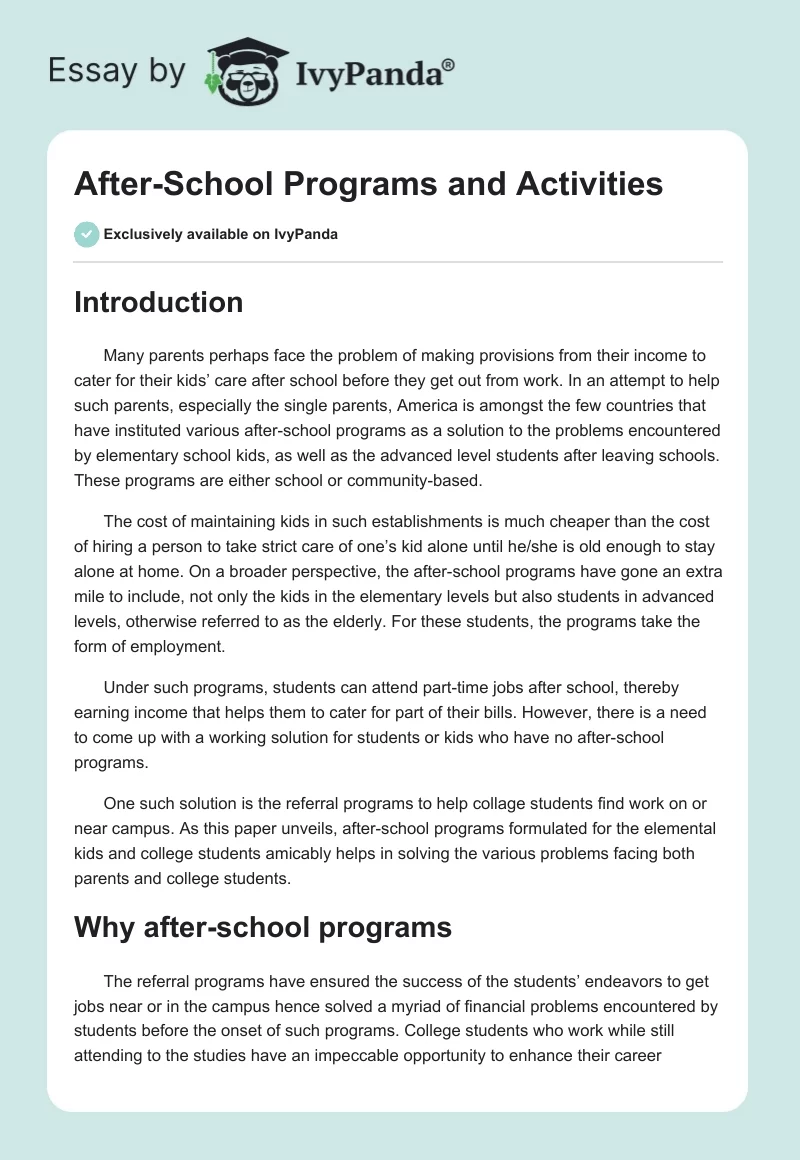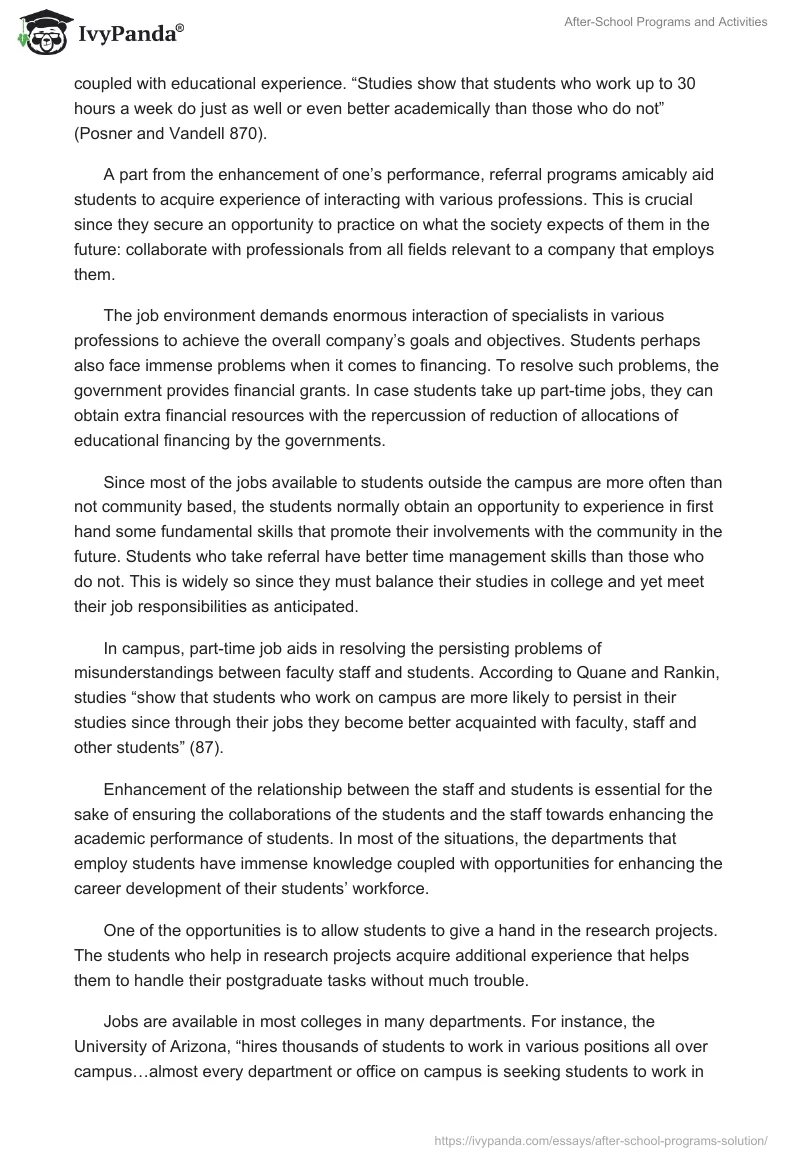Introduction
Many parents perhaps face the problem of making provisions from their income to cater for their kids’ care after school before they get out from work. In an attempt to help such parents, especially the single parents, America is amongst the few countries that have instituted various after-school programs as a solution to the problems encountered by elementary school kids, as well as the advanced level students after leaving schools. These programs are either school or community-based.
The cost of maintaining kids in such establishments is much cheaper than the cost of hiring a person to take strict care of one’s kid alone until he/she is old enough to stay alone at home. On a broader perspective, the after-school programs have gone an extra mile to include, not only the kids in the elementary levels but also students in advanced levels, otherwise referred to as the elderly. For these students, the programs take the form of employment.
Under such programs, students can attend part-time jobs after school, thereby earning income that helps them to cater for part of their bills. However, there is a need to come up with a working solution for students or kids who have no after-school programs.
One such solution is the referral programs to help collage students find work on or near campus. As this paper unveils, after-school programs formulated for the elemental kids and college students amicably helps in solving the various problems facing both parents and college students.
Why after-school programs
The referral programs have ensured the success of the students’ endeavors to get jobs near or in the campus hence solved a myriad of financial problems encountered by students before the onset of such programs. College students who work while still attending to the studies have an impeccable opportunity to enhance their career coupled with educational experience. “Studies show that students who work up to 30 hours a week do just as well or even better academically than those who do not” (Posner and Vandell 870).
A part from the enhancement of one’s performance, referral programs amicably aid students to acquire experience of interacting with various professions. This is crucial since they secure an opportunity to practice on what the society expects of them in the future: collaborate with professionals from all fields relevant to a company that employs them.
The job environment demands enormous interaction of specialists in various professions to achieve the overall company’s goals and objectives. Students perhaps also face immense problems when it comes to financing. To resolve such problems, the government provides financial grants. In case students take up part-time jobs, they can obtain extra financial resources with the repercussion of reduction of allocations of educational financing by the governments.
Since most of the jobs available to students outside the campus are more often than not community based, the students normally obtain an opportunity to experience in first hand some fundamental skills that promote their involvements with the community in the future. Students who take referral have better time management skills than those who do not. This is widely so since they must balance their studies in college and yet meet their job responsibilities as anticipated.
In campus, part-time job aids in resolving the persisting problems of misunderstandings between faculty staff and students. According to Quane and Rankin, studies “show that students who work on campus are more likely to persist in their studies since through their jobs they become better acquainted with faculty, staff and other students” (87).
Enhancement of the relationship between the staff and students is essential for the sake of ensuring the collaborations of the students and the staff towards enhancing the academic performance of students. In most of the situations, the departments that employ students have immense knowledge coupled with opportunities for enhancing the career development of their students’ workforce.
One of the opportunities is to allow students to give a hand in the research projects. The students who help in research projects acquire additional experience that helps them to handle their postgraduate tasks without much trouble.
Jobs are available in most colleges in many departments. For instance, the University of Arizona, “hires thousands of students to work in various positions all over campus…almost every department or office on campus is seeking students to work in their department at some point during the year” (Para.6). These jobs lie under federal work-study program (FWS). According to the University of Arizona, “federal work-study program is a federal financial program that provides a part-time job for undergraduate and graduate students” (Para.7).
However, for students to secure these part-time jobs, they must provide evidence for financial needs. For students who might find opportunities to work in more than one department have the advantage of acquiring multi-professionalism skills. This is critical for future prosperity in one’s career, as the job environment outside campus call for the interaction of various people with different career backgrounds.
Arguably, the students would be at a better position to understand the various challenges of each career and hence would be able to judge the work force that they might be managing in the future. People who are not multi-skilled ends up expecting so much from a given employee, something that he or he cannot be able to deliver.
Referral programs consequently may serve to diminish these challenges among future managers since it gives students that opportunity to work for different departments and or communities before finally settling on their respective careers in the future.
Products of after-school programs
Both the school-based and the community-based after-school programs are instituted to solve problems afflicting students. However, no one factor can singly be identified as subtle to such problems gaps. The problems result from a complex interaction of factors such as family, societal circumstances, individual factors, and neighborhood factors (Cooper 369). Consequently, after-school programs are designed with the need of establishing a compromise between the likely causes of the problems in mind.
Whether at elementally level or the undergraduate level, after-school programs are chiefly meant to increase the students’ learning ability, though at the graduate level, additional benefits such as earning income are realized. The programs not only focus on educational matters but also on increasing the social interactivity skills of the children, as well as their participation in extracurricular activities.
Birmingham et al. conducted a study to evaluate and determine common characteristics possessed by after-school programs that were regarded as highly successful funded by the after school corporation (TASC). They found out that “the data collected during the multi-year evaluation of the TASC initiative to identify projects…contributed to improvements in students’ academic achievement” (Birmingham et al. 1). As argued priory, the after-school programs helps in increasing the students’ performance in academics.
Even though the elementally level after-school programs demands parents to pay the extra amount of money to sustain the school and community-based programs, the result in terms of enhanced children performance in extracurricular and curricular activities is significant. More pertinent to note is that the employment oriented after-school programs available to college students yields similar results.
Enrollment to after-school programs gives a student many opportunities to have exposures to a wide array of new experiences. According to Birmingham et al., these experiences are “in areas of dance, music, art and organized sports” (2). Such experiences can spark in the students’ interests that result to the escalation of the need to work harder in academics in an attempt to achieve even higher goals in their careers, schooling, and their hobbies.
For elementally levels, after-school programs create and enhance the development of children’s literacy skills. These skills are acquired through storytelling, reading, and or writing activities. In the case of incorporation of arts in the after-school programs, kids are able to increase their mastery skills. This is because “arts activities involve practicing new skills in preparation for exhibition or performance” (Birmingham et al. 24). In this context, after-school programs help students to increase their society integration skills.
Another essential product of the after-school programs is perhaps well explained in terms of the problems associated with the likelihood of students to indulge in criminal activities. According to Posner and Vandell, “In high crime neighborhoods, young people may be easy targets for recruitment into gangs or other delinquent activities” (869). As a solution to indulgence in criminal activities, after-school programs increase the time that students spend with people who can mentor them positively, nurturing their skills.
Arguably, the more they spend their time in school and or in the community based after-school programs, the more the chance of establishing relationships with criminal groups dwindle. Consequently, “by providing opportunities for youth to engage with peers and adult role models, youth service organizations help engender the transfer of external assets or linkages to resources which may be beyond the means of family members but which are crucial to “getting ahead” (Quane and Rankin 81).
Because of the increased financial need to sustain their families, parents find themselves working longer hours and hence compromising on the time they could spend nurturing their children positively fortunately after-school programs come in to take up this role.
Conclusion
Therefore, based on the expositions made in the paper, it suffices to declare the after-school program a working solution to the many problems that students and elementary school kids face after school. Ample gaps exist between the elemental children and college students who undertake after-school programs and those who do not. As the paper argues, after-school programs are in place to improve the performance of pupils and students academically.
However, the approach used is rather indirect in that the process of achieving these goals calls for consideration of other areas of focus. These areas include the provision of employment opportunities to students both in and out of campus, participation in extracurricular activities, among others. Nevertheless, the activities that dominate the after-school programs end up fostering the improvement of school performance among pupils and students.
Works Cited
Birmingham, Jennifer, Pechman, Ellen, Russell, Christina, and Mielke, Monica. Shared Features Of High Performing After Scholl Programs: A Follow-Up To The TASC Evaluation. New Yolk: US Department Of Education, 2005. Print.
Cooper, Honston. Relationships between five afterschool Activities and academic achievement. Journal of Educational Psychology 91.5(1999): 369-378.
Posner, Johnston, and Vandell, Douglas. After-school activities and the development of low-income urban children: A longitudinal study. Developmental Psychology 35.7(1999): 868-879.
Quane, Mathews, and Rankin, Botman. Social contexts and urban adolescent outcomes: The interrelated effects of neighborhoods, families and peers on African-American youth. Social Problems 49.3(2002): 79-100.
University of Arizona. University of Arizona Student’s Employment, 2011. Web.


